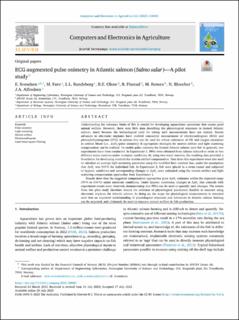| dc.contributor.author | Svendsen, Eirik | |
| dc.contributor.author | Føre, Martin | |
| dc.contributor.author | Randeberg, Lise Lyngsnes | |
| dc.contributor.author | Olsen, Rolf-Erik | |
| dc.contributor.author | Finstad, Bengt | |
| dc.contributor.author | Remen, Mette | |
| dc.contributor.author | Bloecher, Nina | |
| dc.contributor.author | Alfredsen, Jo Arve | |
| dc.date.accessioned | 2024-01-02T08:31:07Z | |
| dc.date.available | 2024-01-02T08:31:07Z | |
| dc.date.created | 2023-08-30T14:08:58Z | |
| dc.date.issued | 2023 | |
| dc.identifier.citation | Computers and Electronics in Agriculture. 2023, 212 . | en_US |
| dc.identifier.issn | 0168-1699 | |
| dc.identifier.uri | https://hdl.handle.net/11250/3109231 | |
| dc.description.abstract | Understanding the tolerance limits of fish is crucial for developing aquaculture operations that ensure good animal welfare. However, there exist little data describing the physiological responses in farmed Atlantic salmon, much because the technological tools for taking such measurements have not existed. Recent advances in electronic implants have enabled concurrent measurement of electrocardiogram (ECG) and photoplethysmograms (PPG) in salmon that can be used for robust estimation of HR and oxygen saturation in arterial blood (i.e., SpO2 /pulse oximetry) if appropriate strategies for motion artifact and light scattering compensation can be realized. To enable pulse oximetry for farmed Atlantic salmon (and fish in general), two experiments have been conducted. In Experiment 1, PPGs were obtained from salmon induced to swim at two different water currents under normoxic conditions. By using two water currents, the resulting data provided a foundation for developing methods for motion artifact compensation. Data from this experiment were also used to calculate an average light scattering parameter using the modified Beer–Lambert law, under the assumption that SpO2 was 100 % for individual fish. In Experiment 2, fish were placed in a swim tunnel and subjected to hypoxic conditions and corresponding changes in SpO2 were estimated using the motion artifact and light scattering compensation approaches from Experiment 1.
Results show that the suggested compensation approaches gives SpO2 estimates within the expected range (95 % to 100 %) under normoxic conditions. Under hypoxic conditions, changes in SpO2 that coincide with experiment events were observed, demonstrating that PPGs can be used to quantify such changes. The results from this pilot study therefore extend the selection of physiological parameters feasible to measure using electronic implants for Atlantic salmon. In doing so, the scope for physiological measurements is extended such that an improved understanding of physiological responses and tolerances in Atlantic salmon farming can be acquired, and ultimately be used to improve animal welfare in fish production. | en_US |
| dc.language.iso | eng | en_US |
| dc.publisher | Elsevier | en_US |
| dc.title | ECG augmented pulse oximetry in Atlantic salmon (Salmo salar)—A pilot study | en_US |
| dc.title.alternative | ECG augmented pulse oximetry in Atlantic salmon (Salmo salar)—A pilot study | en_US |
| dc.type | Peer reviewed | en_US |
| dc.type | Journal article | en_US |
| dc.description.version | publishedVersion | en_US |
| dc.source.pagenumber | 14 | en_US |
| dc.source.volume | 212 | en_US |
| dc.source.journal | Computers and Electronics in Agriculture | en_US |
| dc.identifier.doi | 10.1016/j.compag.2023.108081 | |
| dc.identifier.cristin | 2171016 | |
| dc.relation.project | Norges forskningsråd: 280864 | en_US |
| cristin.ispublished | true | |
| cristin.fulltext | original | |
| cristin.qualitycode | 2 | |
